OVAnime: Winter 2019 Wrap-Up and Retrospective
By: Michael Smith
This article is a follow-up to my original piece on the Winter 2019 Anime Season, in which I gave a brief (sometimes long) review of more or less every anime airing as well as my recommendations. If you were looking for a general overview of shows from last season, give it a read. In this article I will be reviewing the shows I felt were good or interesting enough to follow through with all the way to the end, as such this article will contain some minor spoilers on the premises of those shows. I won’t spoil, say, the big finale of TPN but I will spoil some basic stuff from the show overall and that’s a show you should absolutely go into as blind as possible. Basically if you have any interest in watching a show on this list I’d advise you to actually watch it first before reading the review.
I will also be ranking the top 10 Opening and Ending Themes of the season, in an effort to award “cool points” to the animators who put that extra effort into really showing off their stuff. In order to qualify each theme must have premiered this season and cannot be a holdover from last year. That means for example the first OP for Golden Wind isn’t eligible because that came out last year, but the second one is. Theoretically every anime OP/ED for a given season is eligible, even ones for shows I didn’t review, they just have to be good and/or interesting enough to make the list (and a few of these are in fact for shows I didn’t follow up on). I have attempted to link each OP/ED with a video of their respective entries, but of course the internet is fickle so the links could be pulled literally at any time. Finally I’ll end with a general overview of the season in which I’ll try to determine what, if any, sort of method there was to the madness and compare it to previous seasons.
Top 10 Opening Themes:
What makes a good OP? Well lots of different people look for different qualities in their anime openings and you can watch literal days worth of YouTube videos devoted to solving this conundrum but I’ll attempt to summarize the most coherent points which I tend to agree with. First and foremost, the main point of the OP is to get people to watch the show, obviously. Now a good OP can’t make up for a subpar show just like a fresh coat of paint can’t make a junk car run better, but if you’re on the fence for a show a good OP can be the difference between dropping it and giving it a shot. In order to accomplish this, and OP has to have certain aspects, namely: A. a visual style that makes that show stand out from the crowd of similar looking shows, B. a sense of direction that ties the jumble of moving pictures together into something that can convey what the show is ostensibly about, and C. some thematically appropriate music which fits well with the OP, the show, or hopefully, both. The really great OPs of course also have something a little extra I call style points which are typically some minor touches that elevate the whole thing to a new level.
Now A&B mean a great deal more when evaluating the quality of an OP than C, if I just wanted to listen to some kicking JPop I’d do that and not watch some lame video accompanying it. With that in mind, this list is not ranked by how much I enjoy the accompanying song, in the event of an absolute dead heat between two OPs I will probably break the tie for the one with the better song but that occurs very rarely with these sorts of things. Now with the preamble out of the way let’s get to it.
10. “End Roll” by Hikaru Akao, Shiina Natsukawa, Ari Ozawa, and Inori Minase (The main cast), Endro!
I like themes song by the cast, I like cute themes, I like inventive themes; I especially like cute, inventive theme songs sung by the main cast. In any other season this would be top 5 material which just speaks to the high effort made by animators this season. Anyways the visual artistry is more minimal in this one as compared to the others thus it’s placement but it accomplishes what it sets out to do. It establishes the core players and their general personalities, sets the viewer up for the tone of the series, and gives them a loose outline of the overall plot (such as it is). It does all of this quite well while also including a few neat things like the first ten-ish seconds with the crayon-like cart and the shot of Fai jumping in the water transitioning into a drop of tea into Mei’s cup. All in all a pretty decent OP.
9. “Kaen” (Fire) by Queen Bee (aka Ziyoou-vachi), Dororo (2019)
This one ties in well with it’s title as fire is somewhat of a running theme throughout it. The flames in Hyakkimaru’s eyes, the glowing souls, the burning house, the headless horses wreathed in fire, the fires of war, etc. Past that this is mostly a character study of Hyakkimaru and Dororo, most of it is devoted to their backstories (particular attention is given to episode 6 of the series) and the motivations for their journey together. Otherwise we get the standard shonen action sequences and brief shots of important minor characters to the series. Standard stuff but the rest of the opening makes up for enough in the aesthetic department.
8.“Rakugaki Page” (Scribble Page) by Kankaku Piero, Black Clover
I’ll fully admit I don’t actually watch this show so a lot of the subtle references or foreshadowing in this OP probably went right over my head, but man, if Black Clover were as good as it’s OPs it would be a much better show. I mean come on, the animation quality of the opening seconds showcasing everyone’s powers is absolutely stunning. It’s of course followed by a lot of boring but standard shonen style static group shots, but then that’s followed by fully animated fight scenes. There’s so much sakuga in this opening, it’s really remarkable if only for that aspect, I don’t know how BC of all the shonen battle shows has come out on the top in the OP game. SAO must make a ton of more money than this show but it can’t come up with an OP even half as good as this, I guess A-1 spent all their theme song budget on Kaguya-sama. Anyways, this one looks really fantastic and does some minor artsy stuff so it ranks based solely on those factors. By the way V2 of this OP (post ep 69) is the better version if you’re going to watch it.
7. “Kono Yubi Tomare” (Follow Me) by JUNNA, Kakegurui xx
Like the show it precedes, this opening barely skirts the line between acceptable and nsfw while being pure style. Everything about this opening is sleek and fairly representative of the actual show, a series of random gambling games that are actually just a backdrop for the thinly disguised sex appeal on display by and towards basically every character in the show. This opening very concretely tells you that Yumiko doesn’t just enjoy the thrill of gambling, it’s basically her kink, as is true for pretty much all the characters. Since the show itself is basically all style and no substance it’s honestly on brand for the opening theme to reflect that. As a minor note, I like that the credits are all contained in Hanafuda cards to continue the gambling motif.
6. “Unknown World” by Schrödinger’s Cat and Kotringo, My Roommate Is a Cat
A very cute opening for a very cute anime, this one plays more into the emotional beats of the show than the narrative. We start this opening with Subaru isolated in his world of books, the metaphorical solitary moon, and by the end of the theme, thanks to Haru, he’s been surrounded by friends and we end on the moon and sun holding hands. Other than that it’s just a lot of scenes of Haru being cute and Wishbone esque storytimes with Haru and Subaru acting as the characters in various works of fiction. Again, not exactly deep themes, but emotionally consistent and resonant. Plus they got an artist called Schrodinger’s Cat to sing the opening and that deserves a little credit all on it’s own.
Now we finally start getting into the foreshadowing, this one has a lot of it although it’s all fairly obvious once you know what to look for. There’s also a decent amount of shots straight from the manga though my favorite is definitely the group shot of the gang falling from the sky. More interestingly, this opening can more or less be read as a linear progression of the entirety of the show in miniature. After the opening “kiss the ring” shot the theme fast forwards through most of the events of the first half, we get the events leading up to the gang (stars) breaking off on their own, then the traditional hero shots end with Trish awakening her stand, the arrival in Sardinia, and the final fight with the boss. Also as per usual with JoJopenings, it’s super stylish, again in any other season this would be top 3 material but the competition is just too fierce this time, maybe when David Pro does that thing they always do and V2 of this comes out I’ll rank it higher (and yes I do count that as a separate opening).
4. “shadowgraph” by Myth & Roid, Boogiepop and Others
Now we’re really getting deep into the weird and wonderful world of great anime opening themes. This one was so good that I almost was convinced to watch the rest of the season to see where everything was going, I didn’t end up doing that, but it was close. This is a very David Lynchian style horror theme and I really dig (most of) it, it plays around a lot with the dual identity of the main character, I especially like what seems like a straight rip-off of TLJ with the repeating mirrors shot. I love how the scenes transition when the various supernatural threats (well it’s mostly just Imaginator) stalking Touka are thwarted by the ever present specter of Boogiepop. I like how the winter atmosphere makes everything feel colder and darker. I even sort of love the ending shot where naked Touka embraces her clone and…..sort of makes out with herself? I’m guessing that’s supposed to be Boogiepop offering her some air or something like that, honestly if that part of the theme weren’t so long I’d probably rank this one higher because as it is it kind of takes up a lot of space. Overall this is a very artsy opening that really sets the mood for the type of show you’re about to watch even if that
3. “Touch Off” by UVERworld, The Promised Neverland
Speaking of openings with a lot of imagery, like Dororo‘s opening, this one features fire as a running theme, from the lamp to the falling match, which becomes particularly relevant after the events of the last few episodes. It also ties in well with the endings by introducing the butterfly motif, consistently snuffed out at every turn before finally flying away by the end of the theme as our heroes break through the puzzle piece wall. Beyond the themes I love how much careful attention is payed to which characters show up in what shots, for instance all of the children shown in the fence scene makes a lot of sense with context from the entire series, or the fact that the group shots are in front of a prison style line up. The character introductions are efficient at conveying the general characteristics of our trio; Emma is a real people’s person, Norman makes a lot of plans, Ray is rather solitary and good with machines. They also convey a lot through simple facial expressions, Emma has the most hope and is thus show smiling throughout her hero shot while Ray, who has the least, always has a dour look on his. Really the only thing holding this back is that it reuses some shots just to really hammer it’s point across when I think it would be better served by making some bolder choices, but overall a very solid theme.
2. “Love Dramatic” by Masayuki Suzuki and Yoshiki Mizuno feat. Rikka Ihara, Kaguya-sama: Love is War
This opening really has it all so it’s almost a little difficult to know where to start. The background is consistently filled with hearts and scalene triangles representing both the romantic and scheming natures of the leads. The imagery takes a rather literal approach to the subtitle, portraying the leads various mind-games as literal acts of warfare throughout the theme, from the opening shot to the explosive ending. There’s the decision to cast Chika as the disruptive Joker element and Ishigami as the exasperated Ace. I could spend literal paragraphs on how the psychedelic color combined with the song ties the whole thing together. Even the credits have been stylized to appear as EKG lines, because sure why not throw in that little extra bit of effort. It’s crazy how much time the animation team must have spent on this and yet they still had time to make the entire show looks so good and also make two ending themes, and yet even this top tier opening can’t quite reach the top this season.
1. “99.9” by Mob Choir 100 feat. Sajou no hana, Mob Psycho 100 Season 2
Three years ago, Mob Psycho 100 season 1 brought to the anime world the best opening theme of 2016, and surprising no one, season 2 has brought us the best theme of 2019. Now that might seem a bit premature to declare, after all there are still three more seasons of anime to get through this year, surely one of those could potentially usurp this one and take the throne? I sincerely hope that is the case because that opening would have crossed the threshold beyond human achievement, for in order to usurp the opening theme to Mob Psycho 100 season 2, a superhuman effort would need to be made. I thought long and hard about how to accurately describe perfection in short form animation; maybe I’d talk about all the different styles used in this theme, or the foreshadowing, or the themes, or how well it conveys the willingness of the following show to break the traditional boundaries of eastern animation style. All of these things are self-evident however, all one needs is to posses a basic understanding of the art form of animation and be gifted with sight to realize that what they’ve just comprehended is something beautiful, so instead I’m going to talk about the credits.
Yes that’s right, the actual title credits that are mandated to be included in any opening theme ever made be it live action or animated. Now Michael, that sounds super boring and pointless, I hear you say, and normally you’d be right, even the best attempts at “spicing up” those static little words invading all this gorgeous animation can get tiresome after a while, especially if you can’t even read them. This opening is not like any other though, this opening has dynamic credits, yes that’s right, this opening is so godlike in it’s craftsmanship that the animators took into account the fact that credits would need to be included in the theme and built them in to match with what was occurring at any given point on the screen and I’m going to talk about them scene by scene.
First scene, neon credits introducing author ONE fold into existence, center screen, to match the color scheme of the animated monument to the main leads, these flash out of existence as the monument picks up speed to reveal the planning team, bottom center. Second scene, series composers appear and leave via the white line art backdrop behind the rubik’s cube; meanwhile third scene, lead character designer appears obscured as do the characters, comes into focus as the folding screen passes over and animates the leads, then leaves with the screen. In the character march, series editors appear as billboards before, appropriately, the sound design team is displayed in between giant speakers. In the first kaleidoscope you can see the art directors mirrored in the side panels before rotating into view, this then metamorphoses rainbow style into the music director. In the hexagonal kaleidoscope we seen the song title and music directors fold in like the mirrored panels before jumping off the screen to match Mob’s facial features. Our production team appears throughout the cityscape during the action segments sometimes on the buildings, sometimes with the explosions, before the rubble comes together to form Studio Bones. Finally we end with a closing shot of our giant animated monument to Mob Psycho rotating back into view along with the various studios associated with the project before everything turns black as the spotlights dim out.
The mere fact that I could actually spend an entire paragraph talking about the animation techniques utilized for the credits alone should, I think, be sufficient in helping you to grasp the true potential of this opening. If you’re still not impressed, well, I don’t really know what else to say other than I feel a deep sense of pity since you clearly lack a sense of wonder in your life and that saddens me. I’m here if you need a hug.
Top 10 Ending Themes:
Unlike an OP, the primary purpose of an ED (or ending theme) is ostensibly to list the staff credits and encourage people actually watch through the entire credits sequence instead of just skipping to the next episode. Where the OP is usually bombastic and emblematic of the show you’re about to watch, the ED is reflective of the show you just finished watching. It encourages you to think about what you’ve seen in an episode and appreciate the talents of the people who made it while also leaving you wanting just a little more. As such, unlike with OP’s I’m more forgiving of static imagery and slow paced shots in ED’s than I am in OP’s as long as they’re of a piece with their respective show, tell a consistent narrative, and/or feature a unique art style; as long as it’s coherent and doesn’t interfere overly much with, you know, actually reading the credits then it’s probably a competent ED. Of course if a show wants to go all out for an ED that’s a good way to earn points in this round since a lot of ED’s can be pretty simplistic.
Once again I will be ranking these primarily on whether they have an interesting or unique artistic achievement, how well their tone matches with the overall show, and how cohesive the overall style is. In the event of a tie I’ll err in the favor of the song I prefer but these are not primarily decided based on which ED had the best song. Although this category will be somewhat more subjective than the others since there’s less to work with.
10. “1%” by Wolpis Kater, The Morose Mononokean
This one gets it place mostly due to noteworthy animation style. I can only assume this one was put together using panoramic shots of real world locations in Japan which were then stylized somewhat to fit the art style with the characters inserted over top. This particular technique has been used before, notably quite terribly in Hand Shakers, but the combination of soothing cadence of Wolpis Kater and the Mononokean’s particular style make this attempt work much better than that disaster. A nice song and an interesting artistic choice are just good enough to land this theme the #10 spot despite lacking in the way of deeper meaning.
9. “Modern Crusaders” by Enigma, JoJo’s Bizarre Adventure: Golden Wind
Yeah that’s right, a song from 2000 by a German experimental music project is on this list. In all honesty I initially chose this because I just wasn’t feeling any other contenders, but I actually think it’s novel to have something that isn’t just traditional JPop in this category. The lyrics and feeling of this song particularly fit well with the second half of Golden Wind and even the visual aspects are a little more in depth than one might expect on first glance, there’s a good amount of callbacks and foreshadowing in the Pillar of Stands ™ which I always appreciate in an anime ED. Also the meta nature of having a song by Enigma be feature in a show that has a character named after said band is very amusing to me personally so for all these reasons JoJo pulls off another entry in the anime theme song department.
8. “Zettai Zetsumei” (Desperate Situation) by Cö shu Nie, The Promised Neverland
As I stated in the lead in to this category, I’m much more forgiving of still images in EDs than I am in OPs so this ED still makes it in despite being entirely static shots. The beginning shots paint a picture of the supposed idyllic life at Grace Field House before being overwhelmed the rather frenetic pace of the music which picks up tempo as the song progresses. The butterfly imagery introduced in the OP carries over here with the children being compared to bugs in a collection at the beginning, this later transitions to the only real dynamic elements of the theme as we see the insects flying away before someone I can only assume to be a young Isabella makes a running leap for freedom. This then cuts to just a gorgeous shot of Emma (perhaps hinting at a certain kinship between the two characters) in front of dozens of flying doves which no doubt also symbolize all the innocent children before panning down once again to the blood soaked flowers piercing the children’s clothing underneath. This one does a good at conveying the overall themes of the show while hinting at a larger backstory which is really all you can ask for from a good ED, well that and some innovative animation choices but that’s for later on in the list.
7. “Lamp” by Cö shu Nie, The Promised Neverland
Based TPN joining the double ED club this season with another theme heavy on the symbolism. This one feature much of the same imagery as the previous one except that it’s traded the black background for white. To avoid repeating myself I’ll mention this time that I think the still shots throughout most of these two themes are moving backwards through time from top to bottom which I feel is further reinforced in this one by having the once again dynamic butterfly break transition into a shot of a young Krone followed by someone who I again assume to be a young Isabella. The theme ends with another stylized shot this time of our main trio relaxing under a tree together as there siblings play in the background which once again cuts down to the flowers although this time they’re surrounded by pictures of the various inhabitants of GFH as well as a burnt book (foreshadowing). If these two themes are so similar why have I ranked this one higher you might ask? Well the previous theme ends with a rather perplexing stinger shot of the owl bookmark cipher code thing which really feels out of place with the rest of the imagery and therefore sort of hurts it as opposed to this one which cleanly sets up the events of the big climax of the season. Also I like the song better, I told you this category was going to be more subjective than the last one.
6. “Sayonara Gokko (Pretending to Say Goodbye)” by amazarashi, Dororo (2019)
I feel like amazarashi always gets paired up with the melancholy anime, but hey if it works it works. The tone and lyrics definitely fit the overall themes present in this show as does the more somber color palette. There’s actually a lot of different art styles present in this outro from still shots of the main duo which look straight out of a manga, to more rough, stencil looking art in places to the shadowy look used for most of the theme. It’s quite impressive that it all ties together although I do think the static manga art felt out of place the first few times I watched it which is why this doesn’t rank higher on the list.
5. “Whiteout” by Riko Azuna, Boogiepop and Others
Perhaps the most stylized ending theme on this list, Whiteout reflects the duality and ephemeral nature of the series incredibly well. Roughly the first half focuses on the regular life of Touka Miyashita attending school and hanging out with friends. The theme transitions via several fleeting shots of the eponymous main character before it it becomes more dream like and fantastical, symbolizing the world Boogiepop inhabits. Finally the ending reaffirms the split persona of the leads thereby leaving it uncertain which one is inhabiting the finale scene. Personally I think Boogiepop and Others is a bit too artsy and confusing for it’s own good sometimes but this ending really embraces what makes the show unique and I gotta give it credit for that and for making it visually interesting.
I mean come on, it’s an ending all about a cute cat doing cute cat things, no one should be surprised this is in here. Thematically this is the perfect ending for a show like this, the lyrics are soothing, the images are relaxing, the artist style is vibrant but muted so as not overwhelm the viewer. What better way could one properly covey the experience of having spent a lovely half-hour(ish) with your friend the cat anime while also enticing you back again next week? They even took the time to animate it in a sort of faux watercolor or paint brush style where everything looks hand drawn and illustrated but still very visually clean. I even like the little dynamic elements they’ve thrown in here like the rain drops over the frog scene. Basically the only thing this outro lacks is that it’s not as visually impressive as some of the ones later in this list.
3. “Memosepia” by Sajou no hana, Mob Psycho 100
I like this theme for basically similar reasons as the ending to My Roommate is a Cat just with different emotions and more complexity involved in the process. Once again we see an interesting visual style, this time resembling more of pencil art on paper, this one is significantly more dynamic though featuring full walking animations, kaleidoscope transitions, and even animated scene frames. The song of course matches perfectly with the theme of growth present this season as do the various scenes of Mob interacted with his family and the friends he’s helped and who’ve helped him along the way, heck even the scene frames symbolize various points in the series. In addition to callbacks the theme features a few subtle hints of foreshadowing to future events which become more obvious on re-watch, I’ll only mention “broccoli” for the sake of spoilers. It even has my most beloved of animated theme traditions, (minor) variations across multiple episodes! Yes that’s right, the ending theme animation actually changes slightly episode to episode and I absolutely love that kind of thing in anime even when it’s minor. All in all a solid ending for a show that’s determined to put forth it’s A game in everything it does. My only fleeting wish is that the production team had somehow found time in what must have been an insane schedule for this show to maybe do another ending instead of just two insert songs but c’est la vie.
2.“Sentimental Crisis” by halca, Kaguya-sama: Love is War
Probably the most aesthetically pleasing of the bunch, the first outro for Kaguya re-imagines the central romance as a kind of historical fiction of a sort. I really kind of just like when the outros tell a cohesive narrative in the short amount of time allotted to them and this one accomplishes that in spades. It really maximizes the brief window allotted to it to convey it’s thesis and sort of makes me want to see this alternate version of the story. I could talk about how entertaining it is to see the various re-imaginings of the characters or how it being a dream in the end reflects on Kaguya’s inner feelings but again, the ending perfectly accomplishes this already. It’s just a very solid ending and it’s so dynamic and well animated that it could honestly serve as the opening theme for most shows.
1. “Chikatto Chika Chika♥” by Konami Kohara (Voice of Chika Fujiwara), Kaguya-sama: Love is War
I mean, come on, do I even need to say anything about this one? Well, the animation team somehow found the time in between all the work they did to make Kaguya-sama such a gorgeous show, and the time spent making a fantastic OP, and the time spend to make a great ED. Somehow, despite all this, they still found the time to make a full render of Chika, write lyrics for an original song for the voice actress to sing, and spontaneously invented one of the catchiest, poppy song and dance routines in the history of animation, and it only airs for one episode in the entire season! I don’t know what possessed A-1 to do this for a literal one off ending theme but it worked because the animenet went crazy over this and for good reason, it’s perfect. There’s literally nothing more I want to say about this so I won’t, go watch it, like ten times.
And now the main event:
Winter 2019 Reviews:
Biggest Disappointment:
This category is reserved for shows which had a strong early showing but failed to follow up on their potential and ended up either failing or just not being as good as I think they could have been.
That Time I Got Reincarnated as a Slime
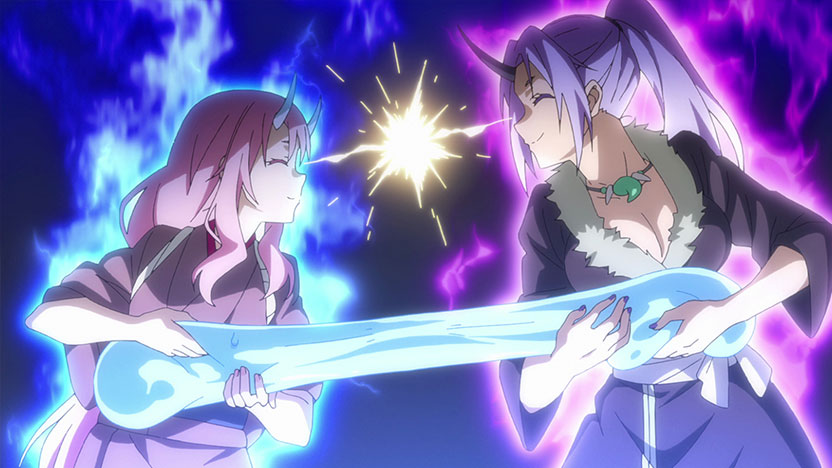 Studio: 8bit, Director: Yasuhito Kikuchi, Writer: Kazuyuki Fudeyasu
Studio: 8bit, Director: Yasuhito Kikuchi, Writer: Kazuyuki Fudeyasu
Completed: 23 episodes
Despite turning in one of the better showings of the Fall Season last year, Slime Time just wasn’t as much fun in the second half leading me to wonder if this show peaked a bit too early in it’s run. Now I’ve placed this show in Biggest Disappointment not because it’s a bad show, as far the standard Isekai fare goes (and especially for this season which had some all time failures in forms of SAO and Shield Hero) it’s probably above average since most of those shows range from unwatchable to aggressively mediocre. No, it is in this category precisely because it is merely a pretty good show, last year Slime really wowed me in it’s opening act which featured an arc focused on a surprisingly empathetic minor character, that arc culminated in one of the best episode of animation I’d seen in the entire year, not just anime, animation period. I suppose I should have seen the decline coming to be quite honest, I had set myself up for failure believing this show could maintain such a high level of execution and was predictably let down when it failed to meet those goals. On the other hand, so many shows this season have managed to maintain that high level of consistency that it wasn’t outside the realm of possibility for this show which had previously shown itself to be capable of such heights.
Beyond my initial disappointment, the second half of this season just doesn’t measure up well, I very rarely felt that the main character would ever lose at any point due to his almost OP status, it really just feels like he’ll always find some way to come out on top in any encounter. Not even the villainous characters suffered any real consequences in the second half, with only some mindless goons actually getting wasted I can’t even feel any tension for the minor characters, all of this really puts a dampener on the fights in the back half, which is sort of a big problem considering how few there were. Instead of ending the season on a somewhat high note of taking down some giant flying shark monster……thing, the last 4 episodes play out like a miniature Harry Potter story with out lead teaching a bunch of grade schoolers how to do magic all proper like. Heck the last episode has like an almost 10 minute recap montage of the series events, a recap montage in the final episode which was already dull enough before then! In conclusion the show really kind of fell off the wagon in way that shouldn’t have been surprising but was and really makes me wonder if that spectacular run at the beginning was actually more of a fluke than a sign of future success, considering it’s been renewed for a season 2 sometime next year I suppose we’ll find out this show can reclaim some it’s former glory.
Final Grade: B-
Runners Up:
This category is reserved for shows that just missed being in the top 5 this season, although I have to say this was a much harder decision than usual, honestly all three of the shows could make the top five depending on how my mood changes on a given day of the week and I consider them all very watchable in their own right.
Dororo (2019)
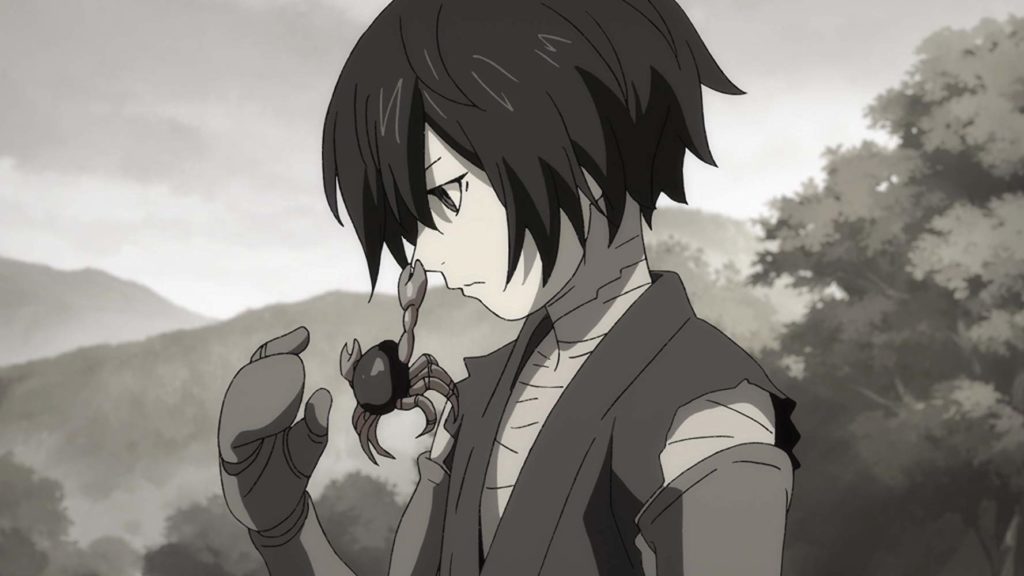 Studio: MAPPA, Director: Kazuhiro Furuhashi, Writer: Yasuko Kobayashi
Studio: MAPPA, Director: Kazuhiro Furuhashi, Writer: Yasuko Kobayashi
Ongoing: Watched 7 episodes as of this review
Originally I had planned to be caught up on this show as with all the others in this list but time, and reality, overwhelmed me and since spring, and thus new anime is upon us, I thought it prudent to just get this one out of the way. Also I plan on watching the show in it’s entirety anyways so I’ll get at least two more chances to offer my takes on it. Dororo hasn’t changed much since last I reviewed it, it’s still a somber take on medieval Japan rife with threats both human and supernatural. Not having their lead of Hyakkimaru even speak a single word until episode 6 of the series is still a very bold choice that I think pays off more than it falls flat, even though I’m not entirely sure how to feel about a character starting off as disabled before magically becoming more abled as the series progresses. The show still manages to wring a lot of pathos out of it’s characters while also not shying away from the grim realities of war and violence. All in all, Dororo is a very particular type of show with a very particular style that isn’t for everyone, but it’s very good at what it’s setting out to do and I look forward to seeing what it can accomplish in it’s second half.
Current Grade: B
The Magnificent Kotobuki
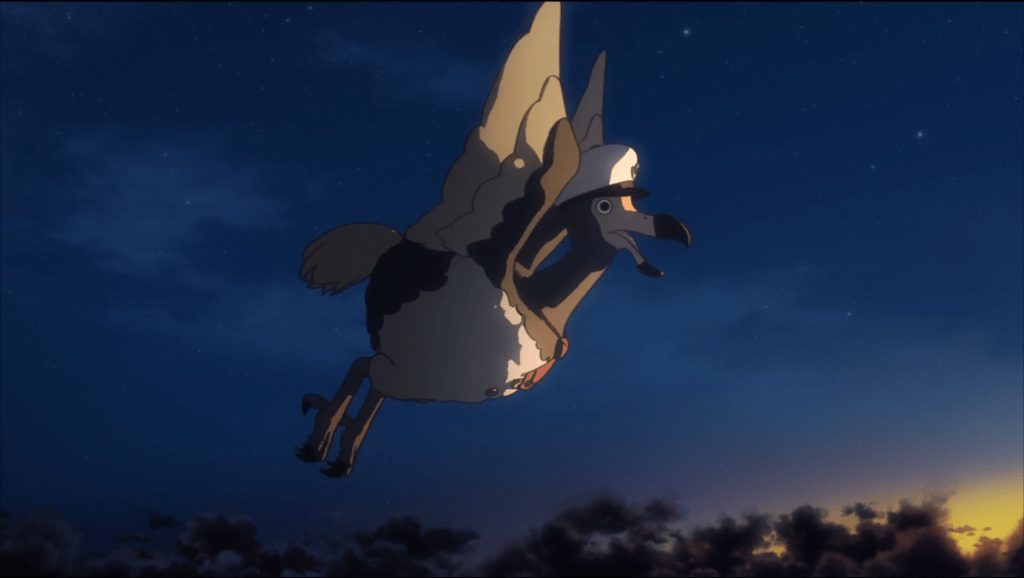 Studio: GEMBA, Director: Tsutomu Mizushima, Writer: Michiko Yokote
Studio: GEMBA, Director: Tsutomu Mizushima, Writer: Michiko Yokote
Finished: 12 episodes
This was a good season for proving that traditionally accepted style of animation aren’t always necessary to make a good product; between Mob, Kemurikusa, and Kotobuki it seems like more animators feel like they can be more inventive with the way their shows look. Now, obviously the 3D models for the main leads never quite matched the 2D backgrounds for basically the entire show, so instead the animators just made more people and planes 3D to cover for that fact and it really payed off in spades with how fluid and dynamic the action scenes look. There are several long scenes of various pilots and planes in flight and they’re all gorgeous to a tee and the sound design is absolutely on point capturing the various squeaks and creaks of the machines. The finale is just a showcase of everything this show is capable of in one long dogfight taking place above, under, and through an entire city and it’s exhilarating to watch. If you’re at all a fan of old school aviation you owe it to yourself to check this show out.
Once you get past the flight choreography the next most interesting aspect of this show is undoubtedly the setting which somehow blends a desolate, wild west wasteland with early 20th century aviation in way that really just works. The dialogue is frenetic and fast, which would normally infuriate me, but actually fits the tone this show is going for really well. This is definitely not a show you can background watch, but if you pay attention you pick up on a lot of details that helps to color in the world and the characters. Speaking of, the characters are rather memorable in their own right, even the minor characters get their chance to shine, although I do wish that more of the leads got more time devoted to exploring their various arcs. Overall this show fits the binge model fairly well, episodes move much faster than most other shows, and leave you wanting more by the end credits, so now that the series is finished it’s actually a good time to watch it.
Final Grade: B+
Run With the Wind
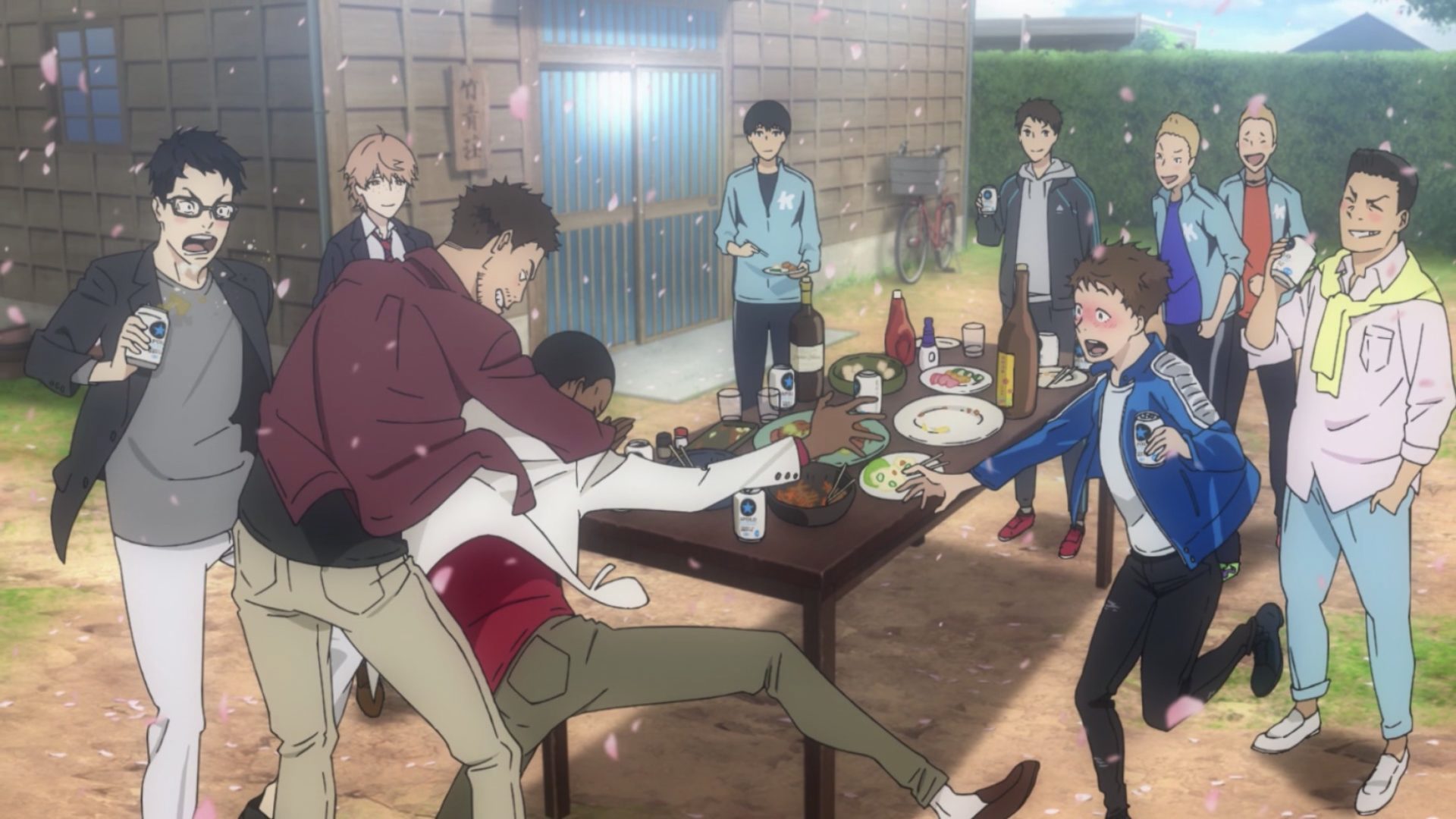 Studio: Production I.G., Director: Kazuya Nomura, Writer: Kohei Kiyasu
Studio: Production I.G., Director: Kazuya Nomura, Writer: Kohei Kiyasu
Finished: 23 episodes
Welp, you’ve finally done it anime, you’ve managed to conceive of a (relative to others of it’s type) down to earth, sports show played entirely straight that I actually like. Normally these types of shows bore me to tears after a while (probably somewhat related to my disinterest in most real life sports) but this one somehow held my interest from the start signal all the way to the finish line. Certainly one aspect contributing to the affection which I hold for this show is it’s honest depiction of the sport, the show doesn’t shy away from the ugliness inherent in marathon running; career ruining injuries, body shaming issue, abusive coaches, athletic elitism, and straight up racism are all touched upon at one point or another over the course of the series. True to it’s name though, RWTW also illustrates what makes people love running; the exhilaration of of surpassing one’s own limits, the freeing sensation of leaving it all behind you on the track, the bonds forged between teammates struggling to achieve a similar goal despite their apparent differences, and the wonder of watching human beings at compete at peak physical performance.
Even at the very end though, this show excels on the strengths of it’s character writing, a concept that seems almost foreign for a sports anime, where the defining characteristics are typically “guts” and “fighting spirit”. This anime is first and foremost a character drama and it fully embraces this fact, every episode in the climax of the series devotes the majority of it’s time to rounding out the character arcs of our ten good boys and pairs them in a complementary narrative fashion. Even the twins, who spend much of the early season indistinguishable, become independent characters in their own right (although they’re still pretty similar in the end). Honestly it’s hard to think another show this season or last season that features a more complex look at the male bonding experience than this one. As per usual, the female presence in this show is still very lacking and my one real complaint would be that the show doesn’t devote enough time to fleshing out the one major female character it has, but I guess I’ll have to wait for a sequel to Hanebado or something like it for the deep female sports anime that I crave. In conclusion, if you’re a fan of an all male cast that’s both surprisingly varied and complex while also delivering on the sports angle, it’s hard to find a better version of that show than Run With The Wind.
Final Grade: A-
Top 5:
5. JoJo’s Bizarre Adventure: Golden Wind:
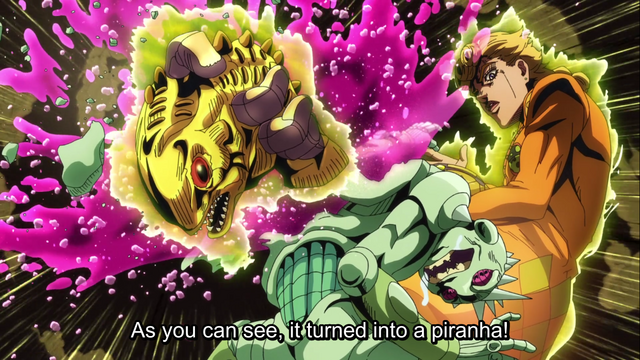 Studio: David Production, Director: Naokatsu Tsuda, Writer: Yasuko Kobayashi
Studio: David Production, Director: Naokatsu Tsuda, Writer: Yasuko Kobayashi
Ongoing: 24 episodes as of this review
The continuing adventures of an Italian teenager who looks 30, speaks entirely in Japanese, and has impossible hair curls as he attempts to become the Gang-Star of the Italian underworld while simultaneously posing in increasingly erotic positions with his magic ghost punching machine. Yes that’s right, the weirdest show in all of the shonen battle genre is still going strong and just as non-committal in it’s blatant unresolved homosexual tension as it ever was. Since we last checked in with our intrepid gang of actual gangsters they’ve acquired a magic storage container in the form of a turtle, turned a guy’s hand into a piranha, experienced the wonders of donut people, and enacted a live replication of Michelangelo’s Pieta with the help of Bakugo on Ice a guy who’s very serious about grammar; and these dear readers do not even come close to being the strangest moments thus far this season. Besides being a vehicle for the strange inner workers of the mind of Hirohiko Araki, GW has also carved out it’s place this season by having unique fight choreography, a surprising amount of character depth, an irreverent sense of humor, and just a ton of style points. The extra time put in by JJBA super stars David Production and the returning series long staff definitely shows.
Somehow, despite the original manga being over 20 years old at this point, Golden Wind remains as one of the most relentlessly weird, refreshing, and all around entertaining shows of it’s type even in 2019. Already strong in it’s beginning arc, GW has turned out several series high-points in this second arc proving that it still has some staying power and didn’t just peak early like some shows. In the absence of Mob Psycho 100, this would undoubtedly be the top of the pack in terms of anime fight scenes, coming in second place to that masterpiece though is still a strong showing and GW still finds to new ways to excite and baffle typical anime viewers. Of course it’s relatively low placement by comparison speaks to it’s particular niche; there’s still only one female character of any significance and every arc more or less concludes with a big fight scene, but not every show can reinvent the wheel and JoJo consistently delivers on it’s strengths on an almost weekly basis. In conclusion, if you’re a fan of shows featuring big beautiful idiots beating each other up with interesting, if sometimes poorly defined, magic powers; JoJo’s Bizarre Adventure still reigns at the top of that enormous pile and Golden Wind has proven itself to be just as deserving of that name as all the other season if not more so. Here’s hoping act 3 can bring us home in style.
Current Grade: A-
4. My Roommate is a Cat:
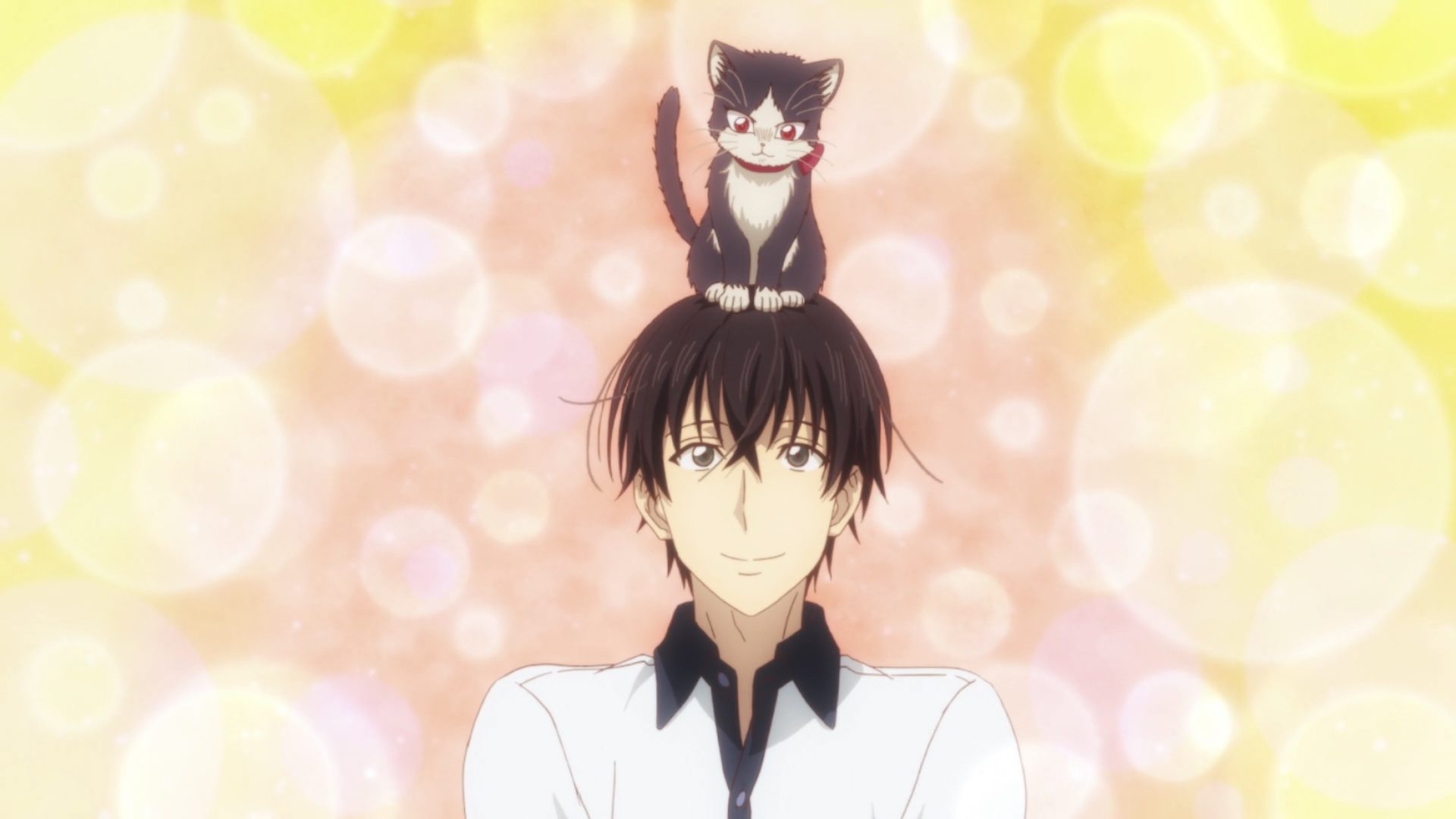 Studio: Zero-G, Director: Kaoru Suzuki, Writer: Deko Akao
Studio: Zero-G, Director: Kaoru Suzuki, Writer: Deko Akao
Completed: 12 episodes
The season (and probably the year’s) best Iyashikei, or “healing”, anime of course centers around the internet’s most beloved of cute animals, the venerated house cat. Unlike some members of this slice of life anime sub-genre, Cat isn’t just interested in spending a relaxing 25 minute segment a week with a cute cat, it wants to actually help people confront their issues and heal from their problems. It accomplishes this task with the intertwining narratives of Suburu and his pet cat Haru who are both wildly different in their overall approach to the world (namely due to being different species) and yet both in a similar state of loss and loneliness. The growth they each display, yes even the cat, over the course of the season lays out a road-map for how one can overcome trauma and grief, expand one’s solitary world to encompass new people, and eventually find comfort through the help of friends and family; be that family man or cat.
Personally I found this show deeply appealing, obviously I like cats and own a cat, so any anime ostensibly about raising cats is kind of my jam. On a deeper level though I can empathize with the rather introverted and emotionally stunted human lead as a reflection of my own youth as somewhat of a shut-in, stay at home type. I think this type of show has a broad appeal to most members of the anime community and serves a great pick me up when you’re feeling sad or stressed. Also, and I cannot stress this enough, that cat is really cute and it’s mere presence on screen makes one’s heart grow in a very Grinchian way. The fact that this is also a surprisingly soulful reflection on trauma and loss is really just the icing on the cute cat cake.
Final Grade: A
3. The Promised Neverland:
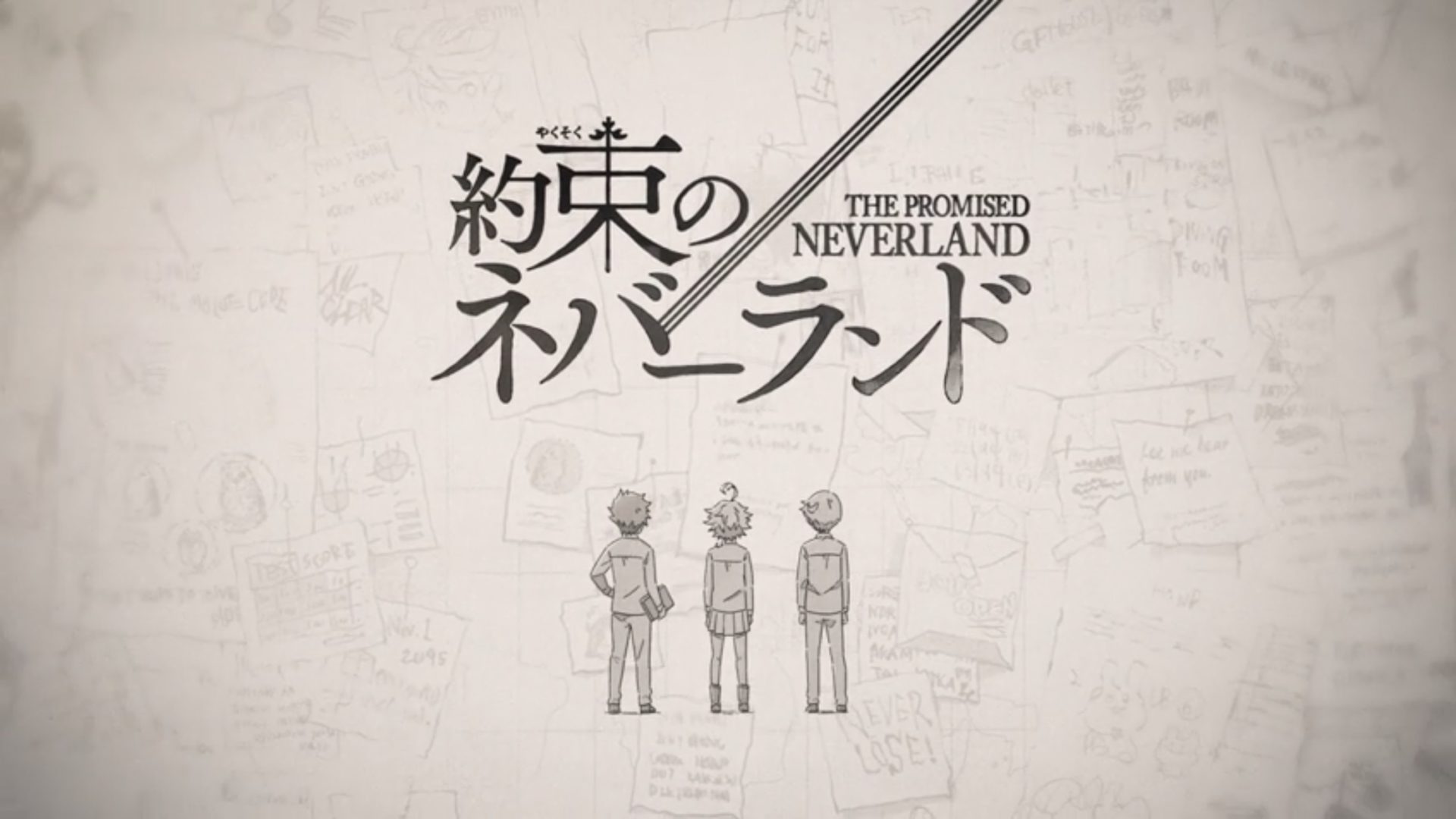 Studio: CloverWorks, Director: Mamoru Kanbe, Writer: Toshiya Ono
Studio: CloverWorks, Director: Mamoru Kanbe, Writer: Toshiya Ono
Completed: 12 episodes
Honestly what more is there to say about a show so good that it demanded immediate weekly podcast coverage based solely on the strength of it’s first episode? Well one could talk about how the show puts on an absolute master class in tension building in every episode. There’s the feeling of triumph as our heroes plans succeed only to be immediately followed up by an emotional gut-punch as a new wrench is thrown into the works. Perhaps the complex characterization afforded to even minor characters which leaves the whole cast seeming more like real, unique people in their own rights. Maybe one could speak on the cinematography on display, used to heighten the already sublime narrative to new reaches. Even the simple plotting of the season could induce one to write an entire article, discussing every twist and turn that comes along, each one both surprising and obvious simultaneously.
However I’d like to keep this article from spanning multiple pages and there’s already hours of content in audio format discussing all these topics and more. Instead I’ll simply state that TPN has, in it’s first season, put forth a handful of some truly spectacular episodes that I’d stack up against any of the other great shows, most of which are in their 4th or 5th seasons. It was a real treat watching three incredibly intricate protagonists (and their not to shabby supporting cast) connive, struggle, and overcome the immense adversity presented to them for the past 12 weeks and I simply cannot wait to see this show continue next year. That this show is only at #3 in the rankings speaks only to the otherworldly, practically untouchable, nature of it’s competition; as a premiere season, The Promised Neverland delivers in way that very few shows ever come close to achieving.
Final Grade: A
2. Kaguya-sama: Love is War:
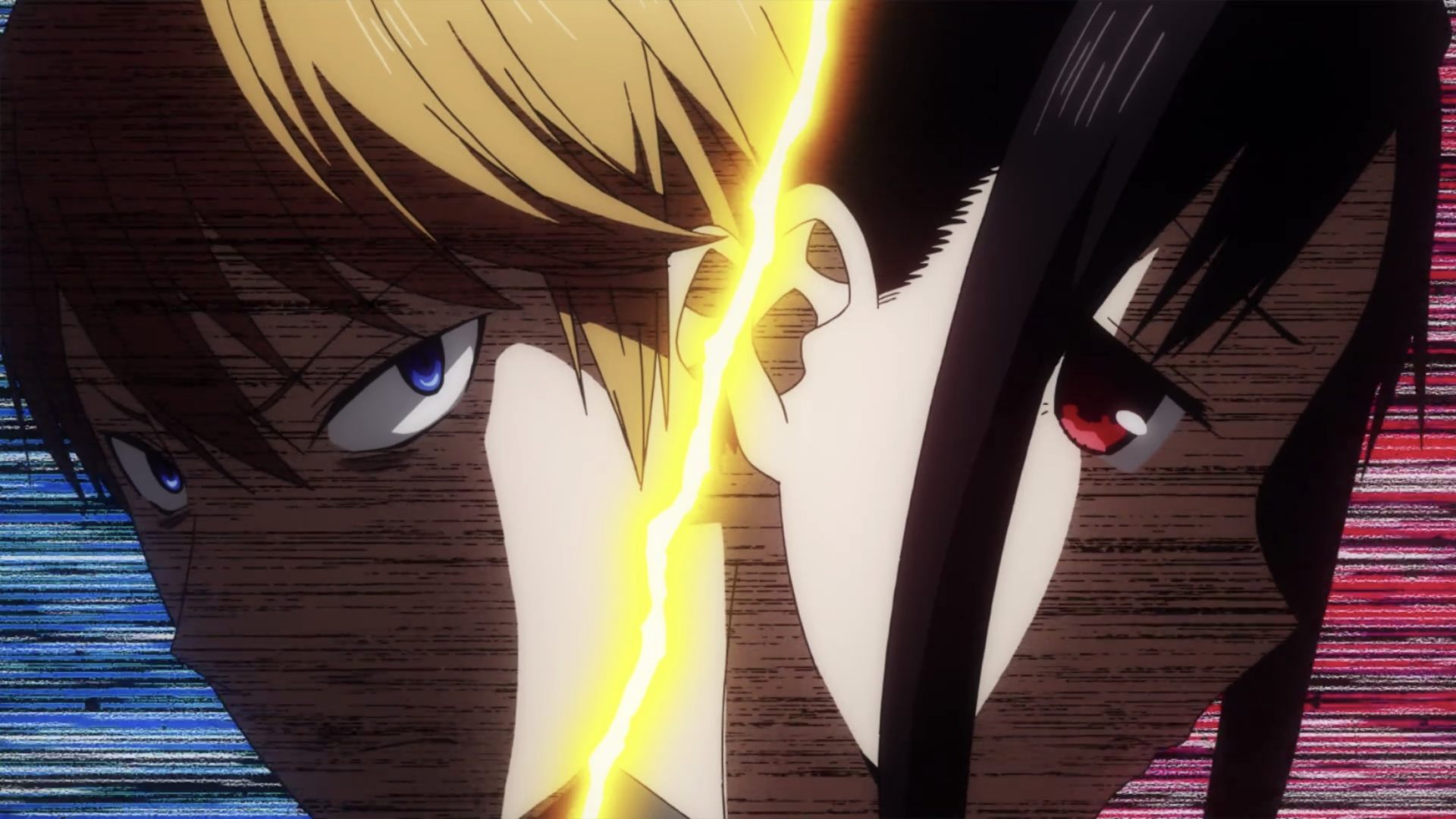 Studio: A-1 Pictures, Director: Mamoru Hatakeyama, Writer: Yasuhiro Nakanishi
Studio: A-1 Pictures, Director: Mamoru Hatakeyama, Writer: Yasuhiro Nakanishi
Completed: 12 episodes
Except of course for the real winner of the best premiere season thus far this year, that’s right, move aside TPN, you should’ve stepped up your mid-season game. As someone who’s considerably harder to amuse than the average person, I find most anime romcoms (or comedies in general) to be somewhat sub-par to their dramatic counterparts. Perhaps then, the greatest compliment I can give this show is that it not only elicited a couple physical chuckles every episode, but also that it’s narrative arcs are generally superior to most of the more “serious” anime of this season. I was initially wary that the central concept of this show would soon get repetitive and jokes stale but the series consistently found new ways to impress me both on a pure entertainment level and by having just a ton of heart. The directing work on this show elevates the already superb writing to the next level with the help of the animation team, they somehow even found time to make two fully animated, extremely high quality ending themes for this show in between all the other crazy amount of work that went into this show.
I don’t have as much to say about this show as some of the others on this list by virtue of it being a comedy first and foremost but don’t let that dissuade you of it’s true talents. Basically every single episode of this show lands and it’s one of the most consistently enjoyable shows I’ve ever had the pleasure to watch. Honestly if I didn’t have slightly more personal affection for Mob this would be easily be my #1 show of the season and it’s entirely due to it’s incredibly strong outing.
Final Grade: A+
1. Mob Psycho 100 Season 2:
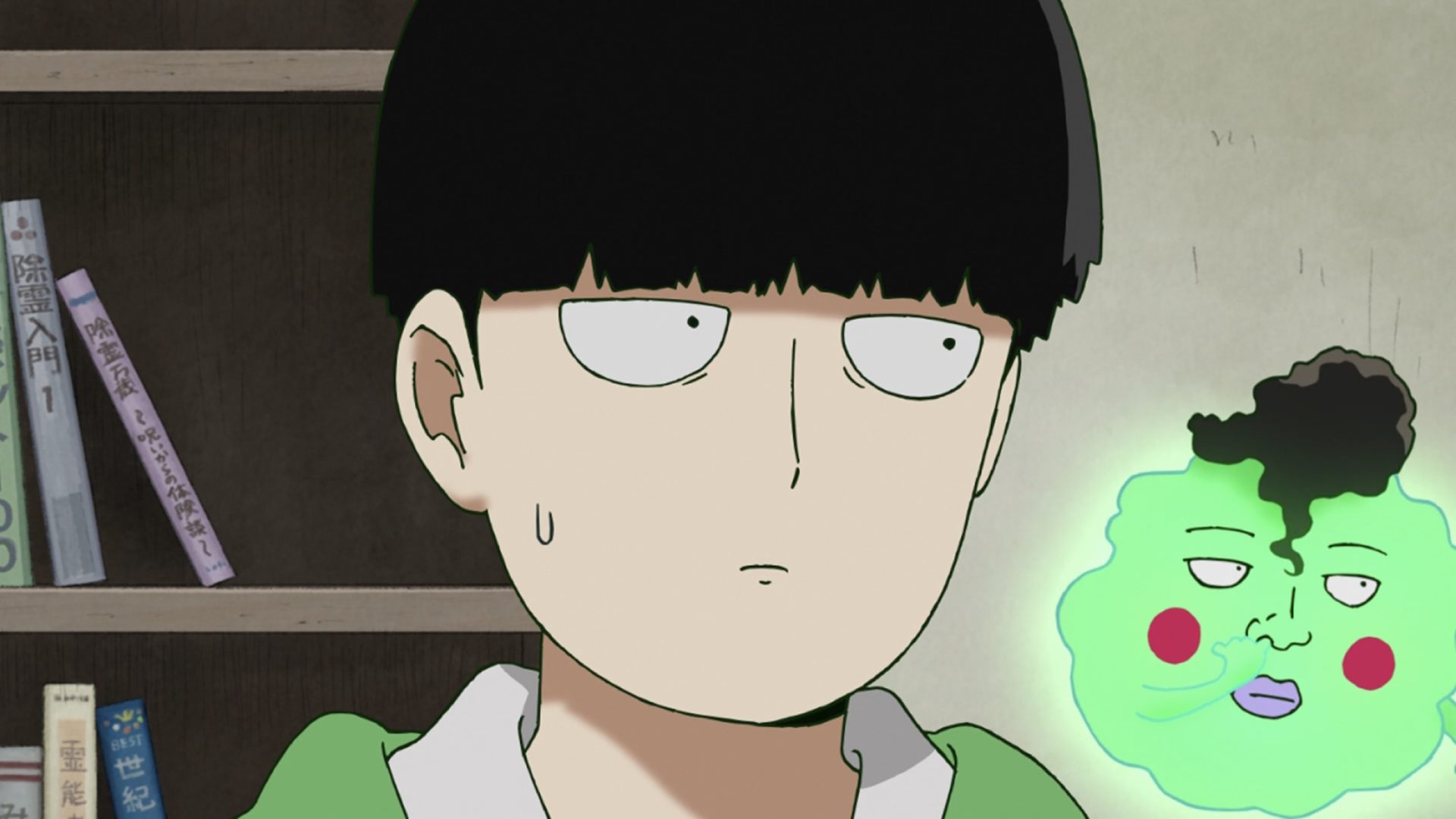 Studio: Bones, Director: Yuzuru Tachikawa, Writer: Hiroshi Seko
Studio: Bones, Director: Yuzuru Tachikawa, Writer: Hiroshi Seko
Completed: 13 Episodes
Mob S2 is perhaps the single-most visually stunning work of animation in the entire field this season and probably will remain so for the entirety of the year. Most shows struggle to even develop their own consistent style by the end of a season, whereas the team behind Mob (the show), not merely content with having the best looking show on the market, decided to just go ahead and perfect several other styles on top of it. Pretty much every episode this season experiments with the conventionally accepted style of how anime is supposed to look and it all pays off spectacularly. This isn’t even a traditional action anime and it’s still got better fight choreography than basically all the heavy hitting favorites. If Mob got by simply due to the strength of it’s animation it would already deserve a spot in the top 5, but season 2 also throws in an incredible amount of pathos and character focus to drive all the insanity.
The season long arc of Mob (the main character not the show) learning how to really express himself and interact with the world around him is beautiful to witness. Throughout the season Mob is confronted with the inherent ugliness of the world he lives in, ranging from small time school yard bullies, to undead psychic assassins, to an organization bent on literal world domination. These conflicts force Mob to confront world views and experiences that are sometimes tragic and sometimes abhorrent, and yet he manages to come out the other side as a more empathetic individual who has a more firm grasp on his convictions. Perhaps the best example of this is a gag from the first episode of the season, having been “convinced” into running for class president, Mob is unable to even muster a single word while on the stand; contrast that with a scenario near the end of the season where Mob, fresh off a pretty harrowing experience, talks some sense in psychic hikikomori who’s been taken advantage of in a way not too dissimilar to Mob’s own background.
On the level of both pure spectacle and complex character narrative, Mob (the show again) excels far beyond the competition and stands out as one of the most consistently enjoyable shows, probably of the whole year. Where most anime struggle to keep up momentum in the middle of their runs, Mob S2 actually drops some it’s best work, episode 5 in particular is a powerhouse and I would encourage everyone reading this to at least watch that episode even out of context. Honestly, if there were somehow some kind of crossover between this show and, say, Bloom Into You, it would achieve a level of perfection attainable only by the gods.. Perhaps then it’s almost a good thing it’s merely a semi-mythical anime instead of a divine anime, I don’t know if human eyes are ready to behold such a work. Regardless, even if the rest of this year’s anime is complete and utter garbage (and knowing anime, most of it will be) it will all have been worth it for me personally knowing that this show exists, probably.
Final Grade: A+
Season Retrospective:
Winter 2019 is a bit inconsistent, there were some really, really good anime this season (see most of the shows on this list, especially the top 4). Unfortunately there were also some incredibly terrible shows (see the Anime Was A Mistake category in my previous article) and a number of frankly mediocre shows in between the two gulfs.This is actually not uncommon for anime seasons which is of course why I do these articles in the first place. Attempting to find the diamonds in the rough is kind of hard as an anime viewer when there’s so much junk in between. I feel like this season has been a bit more……extreme, in that the difference between the quality of the truly awful shows and truly great ones is enormous. There’s really just not another theater of animation capable of producing something so disturbing and gross as Wataten and also something as moving and heartwarming as My Roommate Is A Cat simultaneously in the same season.
Obviously a lot of this has to do with the sheer number of different animation studios at work in the anime business these days, one can hardly expect a studio like A-1 Pictures to produce anything of note when they’re so focused on shelling out SAO for all of linear time, except they did! A-1 Pictures is also behind Kaguya-sama which was one of the best shows of the season and probably the year, there’s no rhyme or reason to it! Even pre-selecting anime quality by studio still isn’t granular enough because more often than not the relative success or failure of an adaptation depends largely on the staff working on it (which is partially behind my decision to begin including this information in the reviews) but even they can still fly or flop for seemingly no real reason sometimes. In the end I’ll definitely remember this as the season which followed Fall 2018, one of the most shockingly progressive seasons of anime I’ve ever seen, by doubling down on the worst, most misogynistic impulses of the medium, and that’s an enormous disappointment. I’ll also remember it as the season that gave me a handful of all time greats, some which have completely reinvented some genres.
I shall be looking forward with both excitement and dread to see if the rest of the year can replicate the successes, or failures, of this season.
One Comment

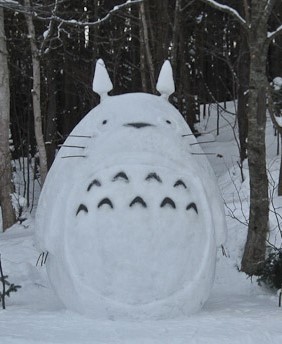
Why is gen:LOCK not on here? It’s on crunchyroll.